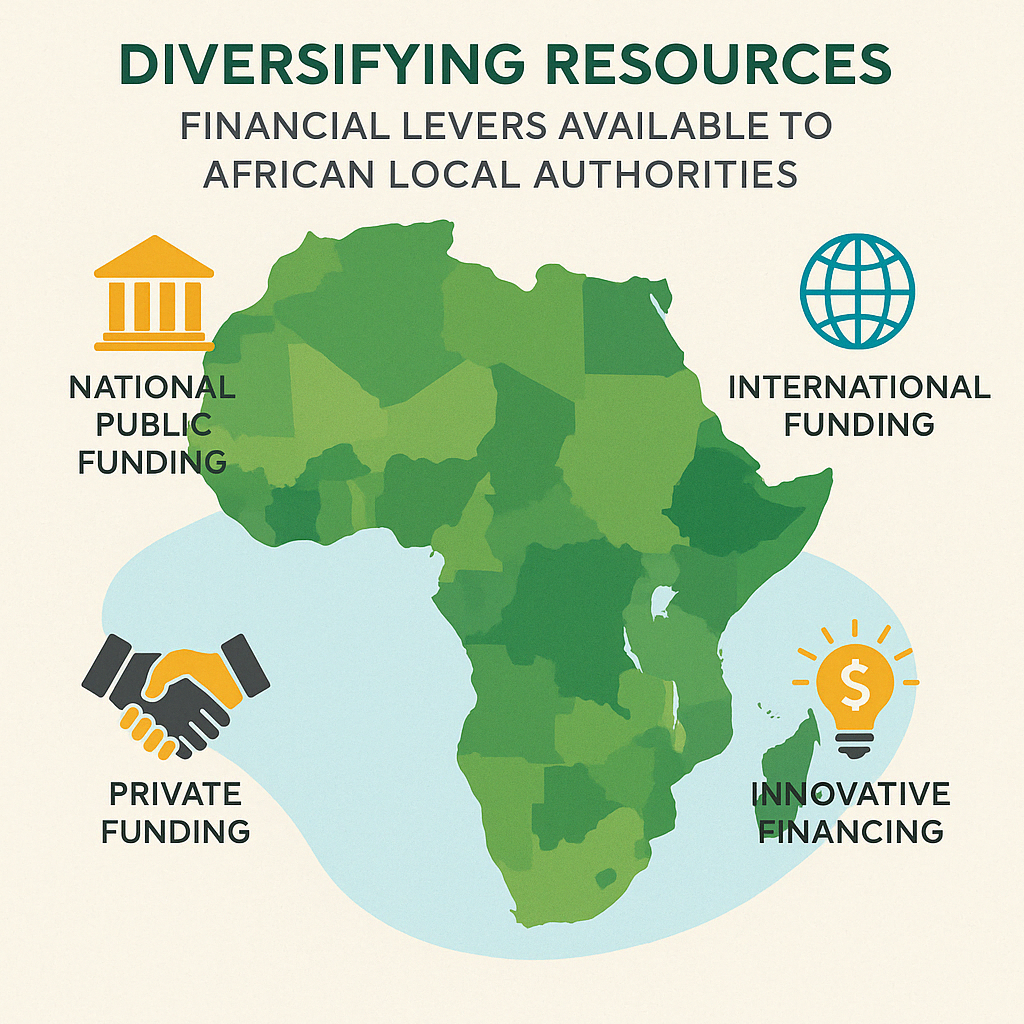The energy transition in Africa cannot be achieved without the strategic and proactive involvement of local authorities. In the first two articles, we highlighted the challenges , obstacles , and prerequisites that determine the commitment of municipalities to the development of renewable energy, energy efficiency, and network modernization. We also emphasized the importance of local governance and the involvement of local stakeholders.
In this third article, we delve into the financial mechanisms available to African communities, before analyzing the models and experiences developed in Germany and the United States. We conclude by highlighting lessons learned and best practices that local stakeholders in Africa can adapt to their context. The goal is to show concrete ways to mobilize resources, ensure project sustainability, and promote equitable access to clean and affordable energy.
I. Diversifying Resources: Financial Levers Available to African Local Authorities

The issue of financing is central when discussing the local energy transition in Africa. Municipalities need multiple and complementary mechanisms to develop renewable energy production, rural electrification, grid modernization, and energy efficiency projects. Below is an overview of the main levers to explore:
1. National public funding: The starting point
These funds often constitute the initial basis of local energy projects:
- State budgets and national subsidies
In several African countries, the state directly supports local authorities through budgets dedicated to electrification or renewable energy. For example, the Global Rural Electrification Program (PERG) in Morocco benefited from significant public contributions and co-financing from municipalities to raise the rural electrification rate from 18% in 1995 to 95% in 2008. Cities and regions that participate in such national initiatives can thus secure part of their budget, even if the state’s contribution often remains limited in many sub-Saharan African countries.
- Dedicated national funds
Several governments have created Rural Electrification Funds (Senegal, Cameroon, Mali, etc.) or specialized agencies to promote access to energy. These funds provide grants or subsidized loans, but often rely on external co-financing. Municipalities must therefore organize themselves to respond to calls for projects and demonstrate the viability of their initiatives.
- Transfers and budgetary decentralization
In decentralized contexts, a portion of national revenues (taxes, electricity fees) is transferred to municipalities to finance their investments. Co- financing is then shared: the State provides technical and financial support, while the municipality mobilizes its resources (local taxes, loans) to supplement the necessary funds.
2. International Funding: Complementing Public Funding
International donors play a key role in meeting capital needs. They are essential for filling national deficits:
- Multilateral and bilateral institutions
Major development banks (World Bank, African Development Bank, French Development Agency, etc.) offer long-term loans , grants , or investment credits at preferential rates. This financing is often negotiated through national governments, but ultimately targets local needs (electrification of rural areas, network expansion for medium-sized cities, etc.).
- International Climate Funds
Mechanisms such as the Green Climate Fund (GCF) and the Climate Investment Funds (CIF) specifically support renewable energy and energy efficiency projects that contribute to the fight against climate change. African local governments are eligible for these, particularly with the support of programs such as the Covenant of Mayors in Sub-Saharan Africa (CoM SSA) or the City Climate Finance Gap Fund .
- Decentralized cooperation and international aid
Twinning partnerships with Western cities, United Nations programs (UNDP, UN-Habitat), and the European Union offer technical and financial support to design and manage energy pilot projects. These grants may seem modest, but they often play a catalytic role in driving innovation at the local level.
3. Private Funding: Capitalizing on Partnership and Innovation
The private sector can significantly accelerate the deployment of local energy solutions, provided that viable models are established.
- Public-Private Partnerships (PPP)
PPPs are a crucial option for attracting private capital and sharing risks. The example of the Stellenbosch municipality in South Africa, which delegated the electrification of an informal settlement to a social operator (iShack), illustrates how a “social” PPP can expand access to electricity through balanced contracts.
- Green bonds and direct borrowings
The most solvent or structured African cities (Johannesburg, Cape Town) have already issued green municipal bonds to finance network expansion, the purchase of clean buses, etc. This approach, which is widespread in the United States, could be extended to other large African cities, provided that local governance and the capacity to structure bankable projects are strengthened.
- Private equity and local banks
Dedicated renewable energy funds (for example, those supported by the AfDB) and local commercial banks are beginning to finance mini-grids, solar power plants, and other green infrastructure. Blended finance arrangements —combining loans, public guarantees, and private investment—are emerging as suitable solutions for countries with perceived high risk.
4. Innovative Financing: Reinventing Local Models
Faced with the limitations of traditional models, solutions adapted to the African context are emerging.
- PayGo Mobile Payments and Microfinancing
Pay-as-you-go solar kits (M-KOPA, etc.), which are widely used in East Africa, demonstrate that it is possible to widely distribute clean energy via mobile money . By supporting these innovations (exemptions, ease of installation), local authorities are contributing to access to off-grid energy for disadvantaged areas.
- Energy cooperatives and community approaches
Some districts, such as Kasese in Uganda, have established community funds that allow residents to gradually acquire solar panels or improved stoves. Energy cooperatives, if strengthened by initial public support, can ensure local and sustainable management of mini-solar or hydroelectric power plants.
- Crowdfunding
Specialized platforms (Trine, Lendahand, etc.) are paving the way for citizen financing for solar and electrification projects. This approach is still limited in scope, but it generates strong social engagement and can complement other sources of financing.
These funding sources offer a wide range, but their effectiveness depends heavily on the ability of local authorities to structure robust projects and draw inspiration from successful experiences elsewhere. Two foreign models are particularly rich in lessons: the United States and Germany.
II. Drawing inspiration from successful models: Africa can analyze and adapt models from the United States and Germany
To better understand how African communities can leverage diverse financing, let’s briefly examine two emblematic cases: the United States and Germany. Their contexts are very different from those of most African countries, but they offer interesting avenues for inspiration.
1. The United States: Local Self-Government and Rural Cooperatives
The American model is based on three major pillars:
- State Autonomy and Municipal Obligations
The United States has a highly developed municipal bond market (nearly $2.9 trillion in outstanding amounts), which is exempt from federal taxes in many cases. Cities and counties can freely borrow to finance their infrastructure (electricity, water, transportation, etc.). Local public power agencies such as the Los Angeles Department of Water and Power (LADWP) issue bonds to modernize their grid or develop solar farms, which strengthens local financial independence.
- Local Public Enterprises and Municipal Services
More than 2,000 municipally owned electric utilities supply nearly 49 million people, reinvesting their profits to benefit the community. The Sacramento Municipal Utility District (SMUD) in California is a prime example: it funds its renewable and energy efficiency projects with its own revenues, under the direct control of citizens.
- Rural Electric Cooperatives
Inherited from the electrification program of the 1930s, more than 800 rural cooperatives provide electricity to approximately 42 million Americans, covering more than half of the country. Owned by their member-users, they operate as nonprofits and remain a pillar of local electricity distribution. Initially supported by subsidized loans from the government, they now ensure the sustainability of their networks and invest in decentralized renewable energy.
Key lessons for Africa
The United States offers an example of strong local fiscal capacity and effective cooperative organization to serve unprofitable territories. Direct access to capital markets is a considerable asset for financing energy infrastructure. The following points are particularly noteworthy:
- Giving local governments the flexibility to borrow and directly manage energy services can make them more responsive and accountable.
- The use of municipal bonds (backed by partial international guarantees, if necessary) opens access to private capital for large-scale investments.
- Cooperatives, supported at the start by subsidized loans or state guarantees, can be a solid lever for rural electrification.
2. Germany: energy remunicipalization, public incentive financing and citizen cooperatives
The German model is based on:
- Remunicipalization and the “Stadtwerke”
The Stadtwerke are municipal utilities that supply electricity, gas, water, and district heating. They account for more than half of the nation’s electricity distribution. Since 2005, there has been a movement toward remunicipalization (the purchase of networks previously leased to private operators) to better control the local energy transition and maintain energy revenues for the benefit of the region.
- Public support dedicated to the transition
The German Renewable Energy Act (EEG) introduced a feed -in tariff , which provides a massive incentive for private and citizen investment. In addition, public banks such as KfW provide preferential loans to municipalities for energy renovations or renewable energy production, while some federal states guarantee loans for cooperative projects.
- Citizen energy cooperatives
Germany has nearly 900 energy cooperatives, often dedicated to photovoltaics, wind power, or biomass. They allow citizens to collectively invest in green energy production, ensuring local anchoring and fair profit sharing. Examples like the EWS Schönau cooperative , which manages its small town’s electricity grid, illustrate the success of citizen ownership and democratic governance in accelerating the transition.
Key lessons for Africa from the German case
Germany demonstrates that decentralization (or even relocation) of energy, supported by targeted public funding and active citizen participation, can accelerate the growth of green energy. Specifically, it emerges that:
- Strong local governance, supported by national incentive mechanisms (subsidized rates, subsidized loans), can stimulate the creation of municipal authorities or local mixed economy companies.
- Citizen involvement through cooperatives promotes social acceptance and the financial sustainability of infrastructure.
- Support from public institutions (development banks, federal programs) is essential to reassure investors and anchor the transition in the long term.
Analysis of these two models reveals that success requires a combination of strong local financial autonomy, targeted public support and active citizen engagement, all of which can be adapted to African realities.
These models cannot be transposed identically, but they offer a valuable source of inspiration. What remains is to translate them into concrete strategies adapted to African realities.
III. Acting Locally: Strategic Recommendations for African Communities
In light of international experience and initiatives already undertaken on the continent, several proven approaches can usefully guide African communities:
- Establish a legal framework conducive to decentralization
- Grant cities and municipalities a legally recognized role in investing in and operating energy infrastructure (mini-solar grids, local biomass power plants, etc.).
- Provide for a clear sharing of tax revenues linked to electricity or renewable production, allowing communities to ensure a share of autonomous financing.
- Opening access to financial markets and guarantees
- Train municipal teams in issuing local green bonds or structuring PPPs.
- Establish partial guarantee mechanisms (via multilateral institutions or investment funds) to reassure investors about the viability of local projects.
- Encourage cooperatives and community involvement
- Drawing inspiration from the model of electric cooperatives to electrify isolated rural areas.
- Facilitate crowdfunding, particularly through the diaspora, by developing reliable and transparent platforms.
- Support the creation of community funds for the group purchase of solar equipment or improved stoves, with a flexible repayment mechanism (microfinance, mobile money).
- Establish economic incentives
- Implement preferential feed-in tariffs for locally produced green electricity or targeted subsidies for community solar/wind installations.
- Unlock lines of credit at preferential rates for municipalities investing in energy efficiency (LED public lighting, energy-efficient buildings) and clean production.
- Strengthening capacities and strategic planning
- Create or consolidate technical units within communities, capable of developing “bankable” projects (risk analysis, business plans, impact studies).
- Participate in international networks and partnerships (e.g. Covenant of Mayors in Sub-Saharan Africa, ICLEI) to exchange best practices and access financial and technical support.
- Ensure transparency and good governance
- Establish rigorous monitoring (audits, reporting) of projects to reassure investors and donors.
- Ensure social equity: the energy transition must prioritize access for vulnerable populations and include subsidy or solidarity pricing mechanisms.
- Adopt a global vision adapted to the local context
- Take into account the realities specific to each territory: energy potential (solar, hydro, wind, biomass), household income level, existing infrastructure.
- Combine different sources of financing (public, private, international, participatory) to structure projects that are robust in the face of economic and climatic hazards.
Conclusion
African local authorities now have an increasingly wide range of mechanisms to finance the energy transition, from national public funding and international donors to public-private partnerships and the most innovative approaches (cooperatives, crowdfunding, PayGo).
The examples of the United States and Germany show that decentralized governance, combined with strong citizen participation and consistent public incentives, can significantly accelerate energy system transformation. While the African context presents specific socioeconomic and institutional constraints, creative adaptation of these models opens up promising prospects.
Sources
- C40 – Cities Climate Leadership Group
- PNUD – Programme des Nations Unies pour le Développement
- Conseil des Communes et Régions d’Europe (CCRE)
- Climate Funds Update
- Albizia Project – Financements innovants
- Banque mondiale – Projets
- Covenant of Mayors in Sub-Saharan Africa (CoM SSA)
- Guide CLDP – Comprendre le financement de projets énergétiques (PDF)
- Programme CEE-ACTEE – Financements 2025 pour la transition énergétique
- Territoires en transitions – Financer la transition énergétique
- Banque Africaine de Développement – Perspectives économiques (chap. 3, 2022)
- ONU Coopération Sud-Sud – Bonnes pratiques dans les PMA (2022)
- FAOLEX – Législation énergétique en Afrique
- NRGI – Partenariats pour une transition énergétique juste












